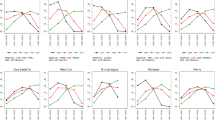Abstract
Log-linear models afford a wide range of tests regarding specific aspects of the association between two ordinal-level variables with identical attributes. This range is considerably broadened when orthogonal contrasts are used to trace changes in these aspects over time. This paper provides descriptions and graphic illustrations of six common log-linear models' applications to mobility data on U.S. white males. The models are then expanded to examine temporal variations in aspects of the mobility regime captured by the respective models. The analysis shows a significant increase over the period of study in the odds that white males from blue collar backgrounds attain higher occupational statuses. Moreover, the findings indicate that blue collar workers are more likely to be drawn from lower status origins during years of economic prosperity, and from higher status origins at times of economic dearth.
Similar content being viewed by others
References
DiPrete, T.A. & Grusky, D.B. (1989). The multilevel analysis of trends with repeated cross-sectional data. Paper presented at the 1988 meeting of the American Sociological Association.
Duncan, O.D. (1966). Methodological issues in the analysis of social mobility. In N.J. Smelser and S.M. Lipset (eds),Social Structure and Mobility in Economic Development, Chicago: Aldine, pp. 51–97.
Duncan, O.D. (1968). Social stratification and mobility: Problems in the measurement of trend. In E.B. Sheldon & W.E. Moore (eds.),Indicators of Social Change, New York: Sage, pp. 675–719.
Duncan, O.D. (1979). How destination depends on origin in the occupational mobility table.American Journal of Sociology 84: 793–803.
Ganzeboom, H.B.G., Treiman, D.J. & Ultee, W.C. (1991). Comparative intergenerational stratification research: Three generations and beyond.Annual Review of Sociology 17: 277–302.
Goodman, L.A. (1972). Some multiplicative models for the analysis of cross-classified data. In L. LeCam, J. Neyman & E. Scott (eds),Proceedings of the Sixth Berkeley Symposium on Mathematical Statistics and Probability, Berkeley: University of California Press, pp. 649–96.
Goodman, L.A. (1979). Simple models for the analysis of association in cross-classifications having ordered categories.Journal of the American Statistical Association 74: 537–52.
Grusky, D.B. & Hauser, R.M. (1984). Comparative social mobility revisited: Models of convergence and divergence in 16 countries.American Sociological Review 49: 19–38.
Haberman, S.J. (1979).Analysis of Qualitative Data. 2 vols. New York: Academic Press.
Hauser, R.M. (1979) Some exploratory methods for modeling mobility tables and other cross-classified data. In K. Schuessler (ed.),Sociological Methodology 1980, San Francisco: Jossey-Bass, pp. 413–58.
Hauser, R.M., Dickinson, P.J., Travis, H.P. & Koffel, J.M. (1975). Structural changes in occupational mobility among men in the United States.American Sociological Review 40: 585–98.
Hout, M. (1983).Mobility tables. Beverley Hills, CA: Sage.
Hout, M. (1984). Status, autonomy, and training in occupational mobility.American Journal of Sociology 89: 1379–1409.
Kirk, R.E. (1982).Experimental Design: Procedures for the Behavioral Sciences, 2nd Ed. Belmont, CA: Brooks/Cole.
Logan, J. A. (1983). A multivariate model for mobility tables.American Journal of Sociology 89: 324–49.
Matras, J. (1980). Comparative social mobility.Annual Review of Sociology 6: 401–31.
McClendon, McKee J. (1977). Structural and exchange components of vertical mobility.American Sociological Review 42: 56–74.
Montgomery, D.C. (1976).Design and Analysis of Experiments. New York: Wiley.
Semyonov, M. & Roberts, C.W. (1989). Ascription and achievement: Trends in occupational mobility in the United States, 1952–1984. In A.L. Kalleberg (ed.),Research in Social Stratification and Mobility, Vol. 8, Greenwich, CT: JAI Press, pp. 107–28.
Simkus, A.A. (1984). Structural transformation and social mobility: Hungary 1938–1973.American Sociological Review 49: 291–307.
Simon, G. (1974). Alternative analyses for the singly-ordered contingency table.Journal of the American Statistical Association 69: 971–6.
Sobel, M.E., Hout, M. & Duncan, O.D. (1985). Exchange, structure, and symmetry in occupational mobility.American Journal of Sociology 91: 359–72.
Tyree, A., Semyonov, M. & Hodge, R.W. (1979). Gaps and glissandos: Inequality, economic development, and social mobility in 24 countries.American Sociological Review 44: 410–24.
Yamaguchi, K. (1987). Models for comparing mobility tables: Toward parsimony and substance.American Sociological Review 52: 482–94.
Author information
Authors and Affiliations
Rights and permissions
About this article
Cite this article
Roberts, C.W., Hoyt, D.R. Models and trends of log-linear association. Qual Quant 29, 17–37 (1995). https://doi.org/10.1007/BF01107981
Issue Date:
DOI: https://doi.org/10.1007/BF01107981




